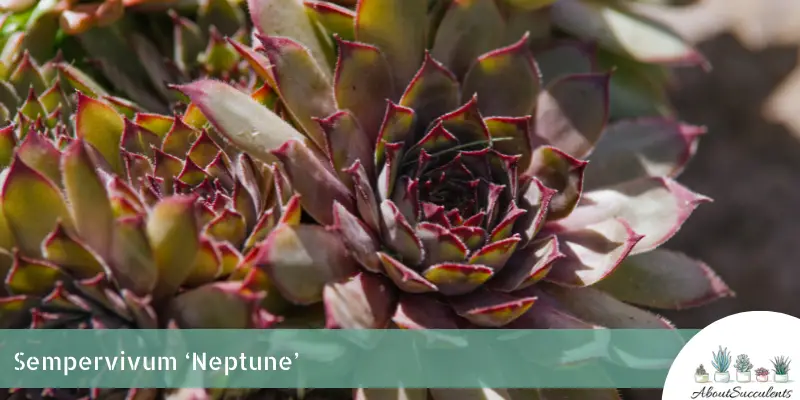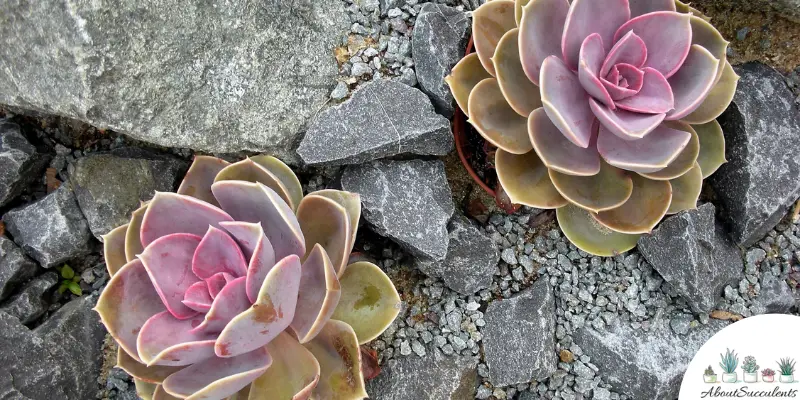
Sempervivum “Neptune”, also known as Silver Suede, is a large, velvety, cold-hardy succulent that perfectly complements a four-season garden.
The hues of its eye-catching rosettes change with the season. The fleshy green leaves get flushed with the colors, pink in spring, dark yellow in summer, and soft purple in fall to winter.
Sempervivum Neptune grows up to 3-inches (7.5cm) tall and 6-inches (15cm) wide. It multiplies fast and grows “chicks” or offsets on stolons. These offsets form tidy clusters that spread out beautifully on the ground or fill every inch of space in a pot.
Typical of succulents that produce offsets, Neptune is sometimes referred to as “Hens and Chicks” or “Houseleeks”.
Silver Suede only blooms star-shaped pink flowers once in their lifetime. As a monocarpic succulent, the mother plant dies after flowering. It’s a good thing, Houseleeks will leave you offsets to propagate the species.
This evergreen perennial is a cold-hardy succulent and can tolerate freezing temperatures down to -28.8° C (-20° F). Many gardeners prefer to plant this succulent in a rock or rooftop garden because it can happily thrive under blankets of snow.
Sempervivum Neptune is a hybrid created by Ed Skrocki and is native to the United Kingdom. It is part of the Sempervivum genus from the Crassulaceae family.
General Information
Also known as: Neptune, Sempervivum Silver Suede, Hens and Chicks, and Houseleeks.
Plant Family: Crassulaceae
Origin: Native to the United Kingdom; hybridized by Ed Skrocki
Height: 3-inches (7.5cm)
Exposure: Full sun to partial shade for up to 6 hours every day.
Water Needs: Drought-tolerant; use the ”soak and dry” watering method
Soil Type: Standard cactus or succulent soil mix combined with gritty materials such as coarse sand, gravel, pumice, and perlite
Soil pH: 6.6 to 7.5
How to Grow and Care for Sempervivum ‘Neptune’

Sempervivum species are very easy-to-care-for. They grow well outdoors and indoors with little attention. There is no need to dote on your Sempervivum ‘Neptune’ for as long as you provide its growing requirements.
Sunlight
Whether planted outdoors or potted indoors, place your Sempervivum Neptune in an area where it can bask under the bright or filtered sun for at least 6 hours daily. Avoid exposure to intense afternoon sun so the leaves will not get sunburnt.
Indoors, place Silver Suede near a sunny window or less than 1 ft from a South-facing window. Turn the pot often so all sides will receive ample light.
When the leaves of your Hens and Chicks plant start to elongate and lose their shape, move the pot to a better location. Low-light settings cause etiolation, where the plant stretches out to seek a light source.
If there is no sunny area in your house, it is best to get a Grow Light for your succulent plant. LED and fluorescent bulbs can provide the full-spectrum light that your indoor plant needs to grow healthy.
Watering
During the summer and spring months, you might water your Sempervivum Neptune once every seven to 10 days. To be sure, check the soil and make sure it has completely dried out before giving it water.
You can test the soil’s dryness by inserting a stick into the soil. If it comes out covered with soil, do not water your plant yet. Now, if the stick comes out dry, then prepare to give the soil a good soaking. This is called the “Soak and Dry” method.
Succulents do not like to sit on damp soil for too long. The roots will rot if you water the plant excessively. The soil can also become a breeding ground for bacteria and fungi.
Pot and Soil
Use a terracotta or ceramic pot with a drain hole for your Sempervivum Neptune. It is made with porous materials that will prevent moisture retention. Never use a pot without a drain hole because the soil will get waterlogged.
When it comes to the pot size, always get one that is 10% larger than the plant’s width. An oversized pot will stress out the fragile roots, while an undersized pot will cramp the roots. Wait for the plant to outgrow its container before you move it to a bigger pot.
Sempervivums thrive best in fast-draining soil. Combine potting soil with a 2 to 1 ratio of gritty materials such as coarse sand, gravel, pumice, and perlite.
It’s not necessary to fertilize the soil but doing so won’t do any harm as long as you dilute the formula to just 25% of its original strength and use fertilizer only at the start of the growing season.
During summer, feed your young Silver Suede with a low nitrogen fertilizer once a week. As it matures, feed it once a week with a diluted liquid 20-20-20 fertilizer.
How to Propagate Sempervivum ‘Neptune’
Sempervivum Neptune can be easily propagated by using its offsets or “chicks” on stolons. Unlike other succulents, Neptune cannot develop a root system from leaf cuttings.
Since it is a cold-hardy succulent, propagation should be done in spring or summer.
Offsets Method
Step 1: Fill a terracotta pot with store-bought succulent or cactus soil. You can also make your potting mix by combining %to 20% compost or potting soil with 80% to 90% pumice and coarse sand.
Step 2: Add half a teaspoon of dry all-purpose fertilizer to every 2 cups of potting mix. Water the soil and allow it to drain until it becomes slightly damp.
Step 3: Gently pull an offset that has already formed some roots from the mother plant. You can also use a sterile sharp knife or pair of pruning shears to cut away the chick from the base of the mother plant.
Step 4: Leave the offset in a well-ventilated shaded area for a few days to allow the cut ends to be sealed or calloused.
Step 5: Gently press the offset into the potting mix. Place the pot in a warm and partially shaded area. Wait for the soil to completely dry out before you water it.
Frequently Asked Questions
Is Sempervivum ‘Neptune’ Toxic to Cats and Dogs?
Sempervivum Neptune is not included in the list of plants toxic to cats and dogs on the website of the American Society for the Prevention of Cruelty to Animals (ASPCA).
Why is my Sempervivum ‘Neptune’ Dying?
If your Sempervivum Neptune starts to look unhealthy, you need to determine the cause and act swiftly to save it from dying.
Overwatering
When the leaves of your Sempervivum Neptune turn brown, swollen, and mushy, you need to treat it immediately. Otherwise, your plant will die from root rot. Sterilize a sharp knife with 70% isopropyl alcohol before cutting off the infected leaves and sections of Silver Suede.
Gently remove Hens and Chicks from the pot and remove all the soil from the roots. Check the roots carefully. Use a sterile sharp knife or pair of pruning shears to cut all the damaged roots.
Leave the plant in a cool and dry area for two to three days to allow the cut ends to be callous or sealed. Fill your pot with fresh succulent soil combined with gritty materials. Repot Silver Suede and wait four days before you water the soil.
Pest Infestation
Sempervivum Neptune is susceptible to mealybugs and aphid infestation. These sap-sucking pests often invade Sempervivums grown indoors or outdoors in damp weather.
If your succulent is planted outside, you can get rid of mealybugs and aphids by introducing ladybugs in your garden. These natural pest controllers can effectively stop the infestation.
If your infested Silver Suede is potted, isolate it immediately. If the infestation is mild, use Q-tips dipped in neem oil or 70% rubbing alcohol to remove the pests.
If the infestation is severe, rinse your plant with water using a pressure hose. Spray it with 70% rubbing alcohol, neem oil, or diluted liquid soap. Do this every week until you get rid of the pests.
During treatment, place your pot in a shaded area to prevent sunburn. It is best to repot your plant and throw away the old potting soil.
Yes. Sempervivum Neptune produces short spikes of pastel blossoms in late summer or fall. It takes several years before Hens and Chicks blooms. It is a monocarpic succulent, meaning it produces flowers once and dies soon after.
Last Updated on June 15, 2022 by Sofia Lara